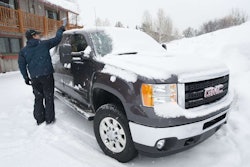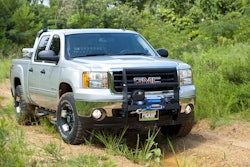DPF Delete: The pros and cons of removing your pickup’s DPF exhaust system
Ever since the first pickup truck was built, owners have been trying to get more power and performance from their engines.
Today this is especially true of diesel pickups, as owners want increased performance and are always looking for ways to achieve their goals.
Most diesel pickups are used for towing or carrying heavy loads; therefore, the desire for more horsepower, torque and performance.
 aFe’s DPF-delete exhaust opens up the diesel engine performance window when used with custom engine control programs.
aFe’s DPF-delete exhaust opens up the diesel engine performance window when used with custom engine control programs.
The good news for pickup owners is the performance aftermarket offers many ways and means to enhance diesel performance.
With the advance in vehicle electronics, companies like Hypertech, SCT, EFI Live and H&S Performance offer programmers/tuners that can increase both horsepower and torque.
But maximum power gains are achieved with the Diesel Particulate Filter (DPF) removed and a custom engine programmer.
However, the aftermarket performance companies offering the DPF Delete Kits are quick to point out their product is solely for closed-course racing and off-road use and is not street legal in any state.
 A typical dealer/installer liability release stating the product sold is strictly for off-road and racing competition.
A typical dealer/installer liability release stating the product sold is strictly for off-road and racing competition.
For that reason, most dealers or installers of DPF delete kits require customers to sign a release and assumption of risk and liability form clearly stating the product is used solely for competition.
Some truck owners feel their pickups are losing power and fuel economy because the DPF filters are plugged and are too expensive to replace when their truck is out of warranty.
This may be true in some cases, but Ford, Ram and Chevrolet now warranty their systems for more than 100,000 miles or five years.
Even so, the EPA mandates that the DPF system be installed for the life for the vehicle.
The Feds and DPF Delete
Because removal of the Diesel Particulate Filter System is clearly against the law in all 50 states, the federal government regulations mandate that the systems be tamper-proof.
 Point your smartphone at the tag in the box to view this form.
Point your smartphone at the tag in the box to view this form.
The EPA can legally come after anyone who physically alters DPF federally mandated emission equipment on all Ford, Chevy/GMC and Dodge pickups, regardless of the fact that they own it.
Section 205 of the Clean Air Act is very clear about the civil penalties: $2,500 per individual consumer pickup truck owner and $25,000 per vehicle for the dealer or installer.
The dealers we spoke with are quite strict about accepting pickups that have had the DPF systems removed.
Because federal law prohibits the operation, sale or lease or transfer of a light-duty truck (1975 or newer, 10,000 pounds gross vehicle weight or less) that has been tampered with, the Ford Chevrolet and Ram dealers we talked with will not accept the vehicle in trade.
One Ford dealer says they make everyone who trades in a diesel pickup to sign a Vehicle Air Pollution Control Statement stating that the owner has not tampered with the air pollution emission control devices. The dealership will not work on vehicles that have had their emissions equipment removed or modified.
In other words, if the owner modifies a pickup and wants to sell it, they better sell it privately, but at a substantially lower price.
New owner vehicle registration is also a problem in states that require the owner to sign a registration form stating the emission controls have not been tampered with.
Keep that in mind if you are a fleet owner with future plans to sell or trade in DPF-modified pickups.
Custom DPF Delete Tuning
Owners who choose to eliminate the DPF system have a number of choices in how to maximize the potential power gains. (Removing the DPF requires some sort of engine programmer modifications so the engine will run properly.)
H&S Performance has a variety of products that will increase the overall performance.
For example, a Ford 6.4L Power Stroke equipped with an S&B cold-air intake, DPF-delete exhaust and Black Maxx race tuner on hot setting went from a stock 306hp at 648 ft.-lbs. of torque to 582hp and a whopping 1,287 ft.-lb. of torque.
The GM 6.6L Duramax, when equipped with an S&B cold-air intake, DPF-delete exhaust and a Black Maxx on the hot setting, went from a stock horsepower/torque rating of 290hp/539 ft.-lbs. torque to 446hp and 845 ft.-lbs. of torque.
A bone stock 2006 Cummins 5.9L equipped with a 4-inch turbo-back exhaust system and an H&S Mini Maxx on hot setting went from 283hp and 510 ft.-lbs. torque to an impressive 482hp and 1,028 ft.-lbs. torque.
Tuning with DPF is legal
Most diesel owners prefer to keep their DPF systems and take advantage of the legal ways to increase their truck’s performance.
These include enhancements from simple DPF-back exhausts, cold-air intakes to programmers that will change the power curve and improve horsepower and torque.
 The 2004 Duromax 6.6L gained an additional 87 horsepower and 173 ft.-lbs. of torque courtesy of the Hypertech Max Energy Programmer and DPF system intact.
The 2004 Duromax 6.6L gained an additional 87 horsepower and 173 ft.-lbs. of torque courtesy of the Hypertech Max Energy Programmer and DPF system intact.
Hypertech offers several DPF-friendly tuners for the Chevrolet Silverado 3500 6.6L V8 diesel.
A good example is the Hypertech Max Energy Power Programmer for a 2005 Silverado, equipped with the Duramax 6.6L engine.
With three stages of performance to choose from, the owner can increase horsepower on average from 32hp and 68 ft.-lbs. torque to 87hp and 173 ft.-lbs. torque.
H&S and SCT Tuning also offer programmers that are designed for use with the DPF.
In addition to tuners, a variety of performance intake and exhaust products are available satisfy increased performance demands for just about any application.
The cost for the added performance depends on how much power and performance you want. Prices range from around $550 for a base tuner to more than $3,000 for a complete performance kit with DPF delete, cold-air intake, stainless down pipe plus other items.
The good news is there are many ways to increase the power and performance of diesel pickups without breaking the law. With proper maintenance, the DPF systems will work properly for many years past the manufacturer’s warranty.
And if the filter is shot, replacement filters are available from the manufacturers as well as aftermarket companies, such as Econix and Cleaire, and run around $2,500 for the filter, sensors and labor.
About the author: Austin Craig pens articles for a number of major automotive publications on a variety of subjects. He is President of Austin C. Craig Marketing and lives in Parkland, Florida.
DIESEL ENGINE AFTER TREATMENT PROCESS
The aftertreatment process was created to meet the ever-tightening federal emissions standards for diesel engines that call for a reduction of nitrogen oxide (NOx) levels.
The Ford solution for its 6.7L Power Stroke V8 turbocharged diesel engine is the Diesel Exhaust Fluid (DEF) method. An injection of DEF to reduce NOx is a proven technology that has been used in the past throughout the automobile industry.
Unlike other ways to control NOx, the DEF system allows the diesel engine to run at its optimum range in terms of fuel mixture; whereas, some systems require the engine to run richer, which can be harmful to diesel engines.
Ford states in its DEF instructions the system is designed so that DEF is replenished about every 7,500 miles, depending on how the customer uses the truck.
The message center will alert the customer if the DEF needs to be replenished. The first message comes when there is around 800 miles worth of DEF remaining. The fill nozzle is located near the fuel cap and is blue for easy access. A heater in the plastic fuel tank prevents the DEF from freezing.
The Ram Cummins 6.7L diesel engine passes the 2011 emission standards without DEF on only light-duty trucks. A NOx Absorber Catalyst (NAC) System is used to regulate emissions without urea fluid.
By controlling the power spike at 1,600 rpm, the NOx is reduced enough for the Cummins to pass the current emission standards. The new Ford 6.7 Power Stroke maintains peak torque of 800 ft.-lbs. through 2,000 rpm with its DEF aftertreatment process.
The Chevrolet SCR system Isuzu-sourced 2011 Duramax 6.6L diesel designed by GM engineers, reduces NOx by 63 percent when compared to the 2010 model.
The SCR, or Selective Catalytic Reduction System, uses DEF. The SCR system is an aftertreatment system, since it treats the vehicle’s exhaust after combustion. Here is how it works.
A fine mist is injected into the exhaust while the engine is running. The heat from the exhaust converts the DEF into ammonia. When ammonia mixed with exhaust gases reaches the SCR catalyst, the NOx emissions are broken down.
The DPF then captures soot to incinerate it during the regeneration process. Finally vapor, nitrogen and reduced emissions exit the exhaust system.
Like the Ford Super Duty, the Silverado 3500 is equipped with an onboard electronic system that provides numerous warnings in the driver information center to maintain adequate DEF levels.–A.C.
SOURCES:
- Ford Trucks: ford.com/trucks/superduty
- Chevrolet Trucks: chevrolet.com/Silverado-3500hd
- Ram Commercial Trucks: ramtrucks.com/commercial
- H & S Performance: hsperformance.com
- SCT Performance: sctflash.com
- Hypertech: hypertech.com
- MBRP Performance Exhaust: mbrp.com
A CLEANER SOLUTION: DPF REGENERATION
There is a new cost-effective solution for diesel pickup owners to have their DPF filters cleaned. FSX Reconditioning (fsxinc.com; 360-691-2999) designs, engineers and manufactures DPF filter cleaning equipment for Ford, Chevrolet and Ram pickups.
The procedure is two-fold, depending on the condition of the DPF:
- A blow-out system that cleans most pickup filters uses highly compressed air to blow through the filter in an FSX specially designed machine. The filter is then flow-tested to ensure it meets the company’s stringent guidelines to return the filter back within original OEM specs. This procedure is a same-day or one-day turn-around and costs about $250.
- If the filter does not pass, it moves on to stage two: thermal cleaning. It is placed in a special kiln and backed for 12 hours, after which it is again subjected to the blow-out process. The burn-out is similar to what the new diesel pickups do on “regen.” The DPF filter is again flow-tested. This procedure takes about two days and costs around $400.
The Chevrolet/GMC filters have to be cut open to access the filter. The Ford and Ram don’t. Cutting open and re-welding the GM DPF adds around $400 to the cleaning costs listed above.
Formed in 2007 in Granite Falls, Washington, a suburb of Seattle, FSX has cleaned more than 20,000 DPF filters to date.
FSX sells or franchises its cleaning system and has dealers nationwide. The FSX Service locator map is featured on its website. Customers can also ship their DPF to the Granite Falls facility. Shipping by UPS runs about $100 each way.
FSX Equipment offers the pickup fleet owner substantial savings over replacement OEM DPF filters.
With the DPF filters costing more than $1,500, plus the cost of new sensors and labor to install, the FSX cleaning procedure can save owners around $1,000 per pickup.–Bruce W. Smith







